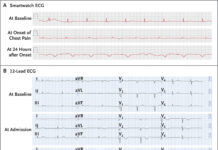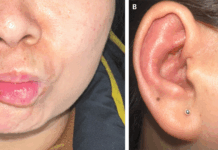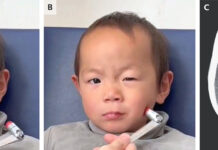A newborn baby boy was brought to the emergency room by his mother on his 32nd day of life with a history of fall from the bed, at a height of 2 to 3 feet, when the baby was alone for a few minutes while the mother was away to warm up milk for him. According to the mother, after the fall he didn’t lose consciousness but was crying inconsolably for a few minutes then suddenly got quiet. This worried the mother so she brought him to the emergency room. The baby was admitted for further evaluation of suspected abuse.
Physical examination revealed normal vitals, absent signs of abuse such as bruises, fractures or subconjunctival haemorrhages. The positive findings were papules on the skin of chest and face, a scratch behind the knee, an erythematous patch near the right nipple and on the left buttock with redness of the intergluteal cleft. Two weeks prior, the baby was given topical nystatin and zinc oxide by the paediatrician for diaper rash. Mother had a positive psychiatric history and reports of being abused by the father of the baby due to which the couple had separated before the birth of the patient, but the father spends time with the baby sometimes. Maternal grandparents of the baby had a history of substance use disorder.
Non-contrast computed tomography (CT) of the head revealed findings suggestive of subdural haemorrhages and intraparenchymal bleedings at multiple locations in the brain. 16 hours later. an MRI was performed which further confirmed the findings. Therefore, a report of suspected child abuse/non-accidental trauma was made, as household falls would rarely result in the intracranial haemorrhages of this sort.

Image Source: New England Journal of Medicine ©
On further enquiry, positive family history of mucocutaneous bleeding and easy bruising prompted the doctors to carry out laboratory investigations to rule out the most common inherited bleeding disorder, von Willebrand’s disease. The positive family history and test results pointed towards a mild form of bleeding disorder involving factor VIII. So the intracranial bleeding during labour was either due to mild haemophilia A or von Willebrand’s disease type 2N, which is a rare variant.
Von Willebrand’s disease (VWD) is the most common genetic bleeding disorder in which there is a deficiency or absence of von Willebrand factor (vWF). VWF is responsible for binding clotting factor VIII to platelets. Any deviation from this process increases the bleeding tendency. Milder forms of vWD is a clinical challenge to diagnose in newborns as neonates have a physiologically higher quantity of vWF in their blood, therefore there have been very few reports of mild vWF causing major bleeds like intracranial bleeding seen in this patient. Positive family history plays a vital role in considering a potential diagnosis antenatally which can aid in planning mode of delivery and also help in directing careful investigations that can be carried out postnatally.
Treatment options for neonatal bleeding disorders include vitamin K prophylaxis, fresh frozen plasma, factor concentrates to replace the deficient clotting factor, cryoprecipitate, platelet transfusions and antifibrinolytic therapy for acute bleeding. Prompt and accurate diagnosis is the key to successful management.
REFERENCES:
- N Engl J Med 2020; 382:656-664 DOI: 10.1056/NEJMcpc1900420
- Lee CA, Chi C, Pavord SR, et al. The obstetric and gynaecological management of women with inherited bleeding disorders review with guidelines produced by a taskforce of UK Haemophilia Centre Doctors Organization. Haemophilia 2006; 12: 301-336.
- Relevance of Abusive Head Trauma to Intracranial Hemorrhages and Bleeding Disorders. Anderst JD, Carpenter SL, Presley R, Berkoff MC, Wheeler AP, Sidonio RF Jr, Soucie JM.Paediatrics. 2018 May; 141(5)




